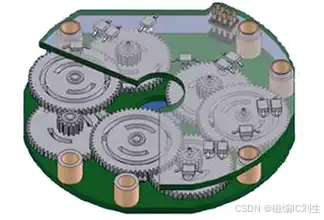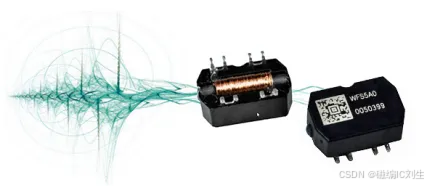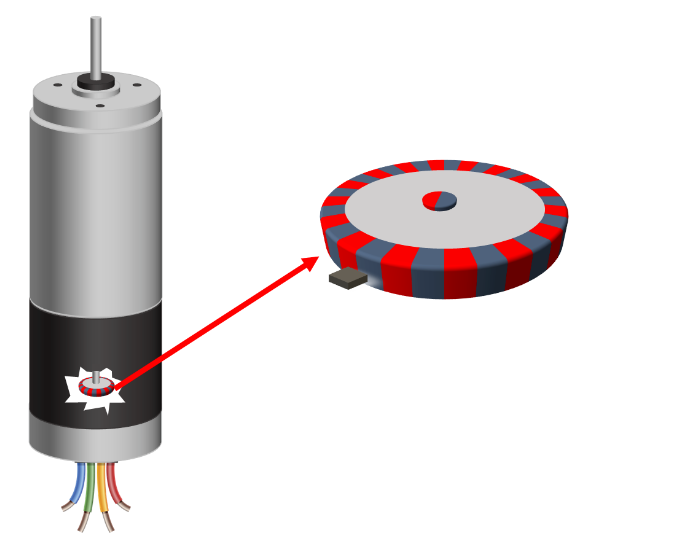I. Overview and Classification of Absolute Encoders
An absolute encoder is a sensor that directly outputs the shaft’s angular position information. Its core characteristics are position uniqueness and power-off memory function. Even if the shaft continues to rotate after a system power loss, the encoder can immediately feedback the current absolute position information upon power-up without requiring a homing operation, significantly improving system reliability and efficiency.
Based on their measurement range, absolute encoders are mainly divided into two categories:
- Single-Turn Absolute Encoder: Its measurement range is limited to one rotation of the shaft (0-360°). Within this range, any position corresponds to a unique absolute code value. It allows setting the zero point at any position or setting the current position to any value, offering high flexibility.
- Multi-Turn Absolute Encoder: Based on single-turn encoding, it adds the ability to record the number of rotations. Its output value consists of two parts: the “number of turns” and the “angle within the turn,” together forming a globally unique absolute position value. This means it can provide absolute position feedback over a larger mechanical range, making it an essential choice for long-stroke and high-reliability applications.
Currently, encoders widely use digital interfaces for communication, such as Modbus RTU, CAN/CANopen, SSI, BISS, Tamagawa protocol, etc. They also support incremental or analog output methods like ABZ, PWM, analog voltage/current.
II. Magnetic Encoder Solutions for Single-Turn Absolute Encoders
Compared to traditional optical encoders, magnetic encoders have inherent advantages such as resistance to contamination, vibration resistance, and lower cost. The implementation scheme for a single-turn magnetic encoder is simple in structure, primarily consisting of a radially magnetized magnet and a magnetic encoder chip.
To address different accuracy needs, OTV provides mature chip solutions:
- Cost-Effective Solution (Medium to Low Accuracy Scenarios):
- Recommended Chip: OTV78 Series
- This series is a non-linear auto-calibration magnetic encoder chip. Leveraging excellent auto-calibration and non-linear compensation capabilities, it can flexibly handle complex industrial environment requirements such as wide magnetic field ranges and uneven magnetic fields. It is fully capable for cost-sensitive applications requiring reliable absolute value output.
- High-Performance Solution (High Accuracy Scenarios):
- Recommended Chip: OTV59 Series
- This series is a high-speed, high-resolution magnetic encoder chip designed for ultimate precision and dynamic response. Its single-pole pair subdivision angular resolution is as high as 24-bit, and it integrates dual 16-bit 2MSPS SAR ADCs, providing powerful hardware support for complex signal processing, easily meeting the application requirements for 17-bit and above ultra-high precision.
III. Technical Paths and Magnetic Solutions for Multi-Turn Absolute Encoders
The technical core of multi-turn encoders lies in how to reliably record and store the turn count information. Currently, there are three mainstream schemes:
- Mechanical Gear Multi-Turn Scheme (Purely Mechanical):
- Principle: This scheme uses a set of precision reduction gears to convert the multiple rotations of the main shaft into fewer rotations of a secondary shaft. Each gear is equipped with a magnet and a magnetic encoder chip. By detecting the absolute position of each stage of gears, the total number of turns is calculated through the mechanical transmission ratio. Its essence is using mechanical position to determine the code, where each position is unique and requires no power-off memory.

- Characteristics:
- Advantages: Truly independent of any power source, extremely high reliability, long lifespan.
- Disadvantages: Complex structure, high cost, potential for mechanical wear, and has a maximum turn limit (usually 4096 to 65536 turns).
- OTV Solution: Can provide OTV78 or OTV59 series chips for the magnetic encoding of each gear stage to achieve high-precision position detection.
- Principle: This scheme uses a set of precision reduction gears to convert the multiple rotations of the main shaft into fewer rotations of a secondary shaft. Each gear is equipped with a magnet and a magnetic encoder chip. By detecting the absolute position of each stage of gears, the total number of turns is calculated through the mechanical transmission ratio. Its essence is using mechanical position to determine the code, where each position is unique and requires no power-off memory.
- Battery-Backed Pulse Counting Scheme (Electronic):
- Principle: This scheme is essentially a “single-turn absolute system + electronic turn counter.” The core is still a single-turn absolute system, with the addition of a low-power TMR magnetic switch to detect the zero-crossing point (or a specific point) of each turn and generate a pulse. An embedded microcontroller (MCU) and a backup battery count and store these pulses to record the number of turns.
- Characteristics:
- Advantages: Theoretically unlimited turns (only limited by counter bit length), relatively simple structure.
- Disadvantages: Relies on a battery to maintain turn information; the battery has a limited lifespan (usually 5-10 years), requires periodic replacement, and is unsuitable for maintenance-free applications.
- OTV Solution: Can be implemented using a combination of OTV78 series (for single-turn detection) + OTV90 series (near-zero power consumption TMR switch chip). The ultra-low power consumption characteristics of the OTV90 series TMR switches can significantly extend battery life.
- Battery-Less Energy Harvesting Multi-Turn Scheme (e.g., Wiegand Effect):
- Principle: This is an innovative battery-less solution. It integrates a miniature energy harvesting generator inside. When the encoder shaft rotates, tiny amounts of electricity are generated through electromagnetic induction or the piezoelectric effect. This energy is used to trigger the internal turn counter and write the latest turn count data into non-volatile memory (NVM, such as FRAM) for storage.

- Characteristics:
- Advantages: Completely battery-free, maintenance-free, combining the power-loss safety of mechanical multi-turn with the high precision of electronic types.
- Disadvantages: Technologically complex, highest cost, usually requires a certain rotation speed to generate sufficient energy for writing.
- OTV Solution: Can provide high-precision OTV59 series chips for the single-turn absolute detection part within this system.
- Principle: This is an innovative battery-less solution. It integrates a miniature energy harvesting generator inside. When the encoder shaft rotates, tiny amounts of electricity are generated through electromagnetic induction or the piezoelectric effect. This energy is used to trigger the internal turn counter and write the latest turn count data into non-volatile memory (NVM, such as FRAM) for storage.
Summary
Magnetic encoding technology is playing an increasingly important role in the field of absolute encoders. Single-turn absolute encoder solutions are very mature, and engineers can flexibly choose between the OTV78 and OTV59 series based on accuracy requirements. For multi-turn encoders, the three schemes each have their merits:
- For pursuing ultimate reliability and maintenance-free operation, the mechanical gear scheme can be chosen.
- For pursuing high cost-effectiveness and超大 (very large) turn counts, and accepting battery replacement, the battery pulse counting scheme (OTV78 + OTV90) can be chosen.
- For pursuing future trends and battery-free maintenance, the energy harvesting scheme (e.g., Wiegand) can be chosen, paired with a high-performance OTV59 chip to ensure single-turn accuracy.
OTV provides flexible and reliable core choices for various absolute encoder designs through its full range of magnetic encoder chips and TMR sensor solutions, supporting the development of high-end applications such as industrial automation, robotics, aerospace, and more.

